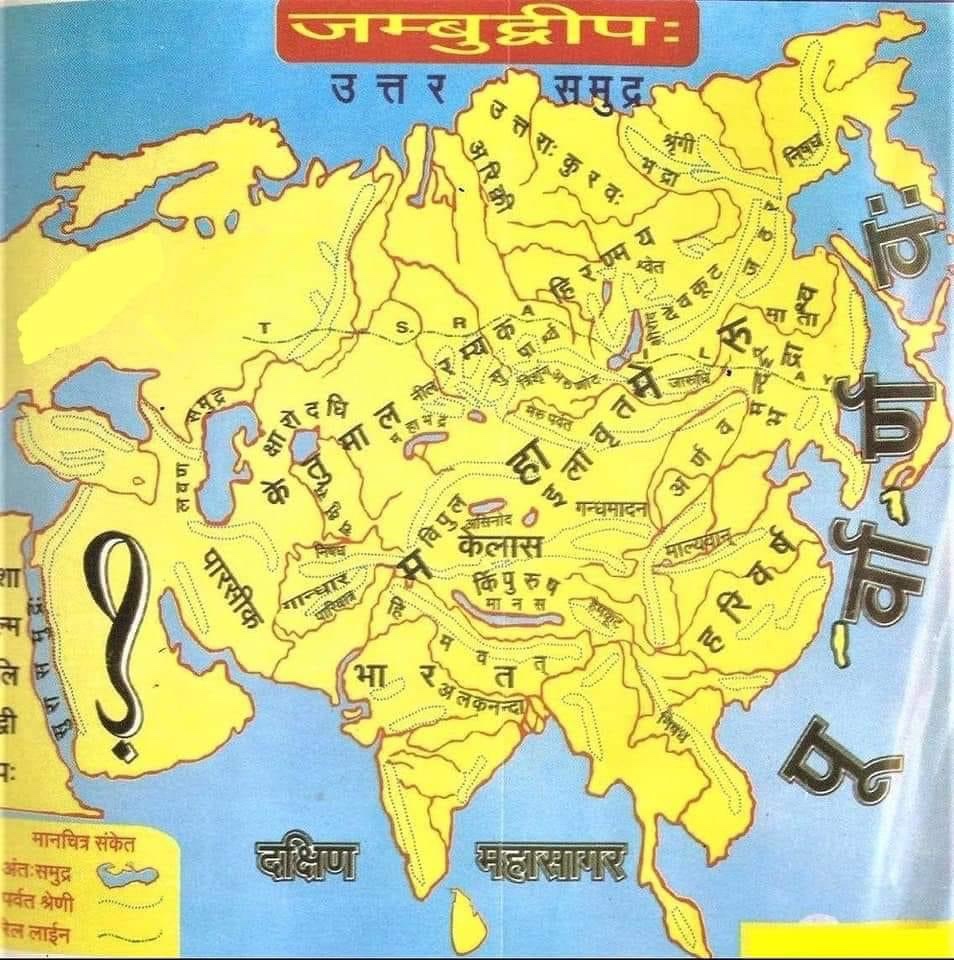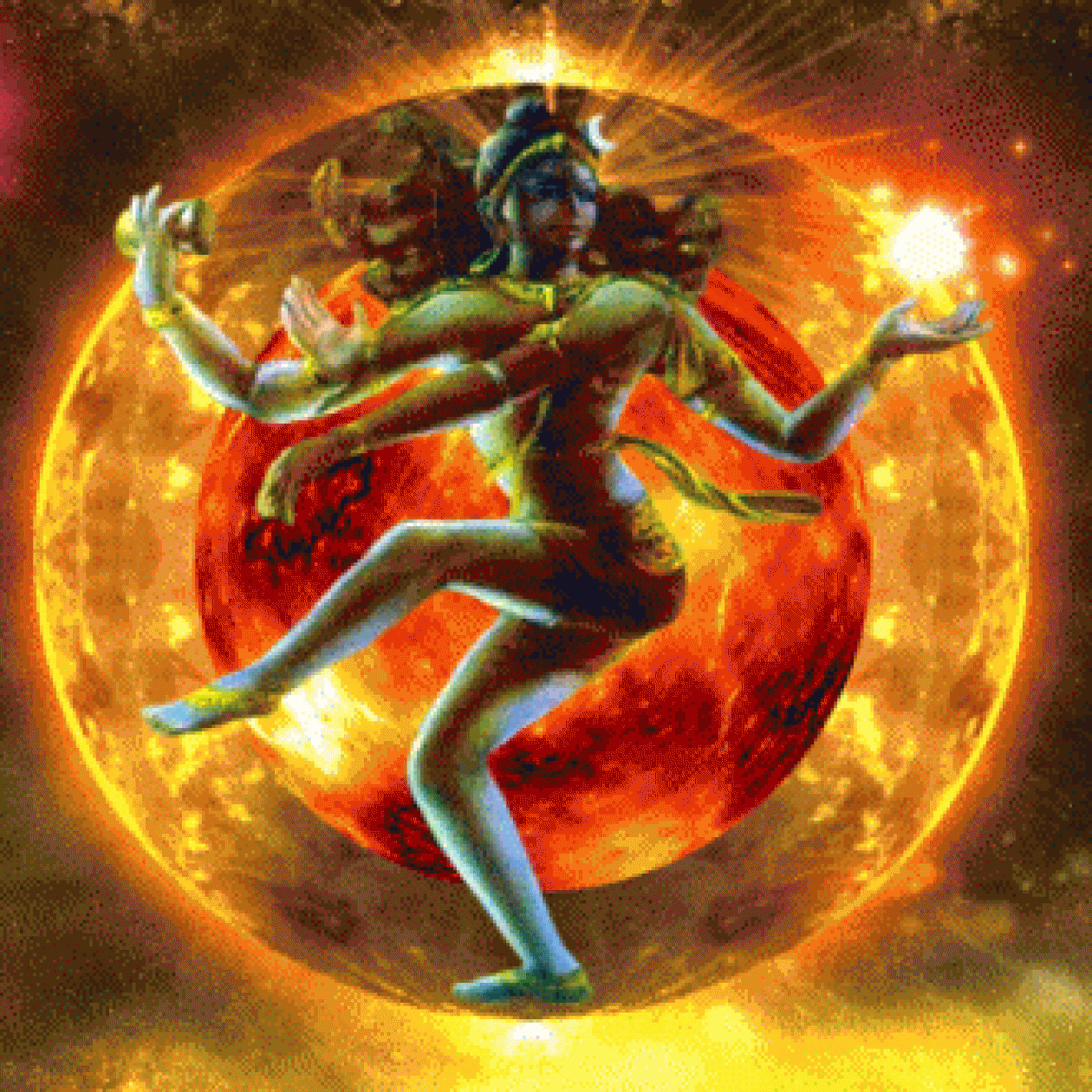Jamboo Dweep

Description of Jambudweep; Vedic Cosmology
According to Vedic geography of terrestrial world, the earthly plane is much larger than we think. And we live in the smallest plane. The seven islands of Jambu, Plakṣa, Śālmali, Kuś, Kraunch, Śāka and the seventh Puṣkar are surrounded on all sides by the seven oceans of salt water, sugarcane juice, wine, ghee, curd, milk and fresh water. Here, these different oceans are based on the colour, taste, chemical properties etc.
As for Brahmanda Purana, it is said that Brahma himself narrated the entire purana to the sages in the Naimisha forest. It is termed as Brahmanda Purana because it talks about the origin of the cosmic egg and the reality of the universe. Basically, Brahma in Sanskrit means “creator” or by extension, it means “universe” coming from its root word “Brih” ; “Anda” means “egg”.
Therefore, Brahmanda means universal or cosmic egg. Brahmananda Purana is the 18th Purana. It has 12000 verses. The three important sections in it are: (a) The Mokshada Ekadasi (narrated by the god Krishna to the Pandava King Yudhishthira), (b) The Lalitopakhyanam about Devi Lalita Tripura Sundari, also contains the Lalita Sahasranama Stotra and the Lalita Trishati Stotra, and (c) The Sons of Sagara story by Rishi Jaimini according to which they dug into the earth to find a horse in Patala loka.
Brahmananda Purana has four parts; Prakriya, Anushanga, Upotaghat and Upasamhar. This Purana is said to be narrated by Sutaji on the bank of the river Drishdvati in Yaksh kshetra (identified with Sutlej in modern Himachal Pradesh). From his narration, it is clear that Sutaji had heard the Purana from Veda Vyasa who, in his turn, received it from Vayudev. Creation of the universe, determination of Kalpa, differentiation of Yugas, description of Manvantaras, description of Jambudweep and Bharatvarsh, description of Kimpurush.
Anudweep, Ketumaal varsh etc. and description of Bharat vansha, Prithu vansha, Dev vansh, Rishi vansh, Agni vansh and preceptors are the main topics of Brahmand Purana. Sages, the dynasties of rulers and the legends of Pitas and their propitiation, the conflict between Karttikeya, King of Hihayas and Bhargava Parasurama. Jambudweep is situated in the middle of all these concentric islands. In the middle of it is also the golden Sumeru (axis of universe). Its height is eighty-four thousand yojanas and towards the bottom it is sixteen thousand yojanas embedded in the earth. Its expansion is thirty-two thousand yojanas in the upper part and only sixteen thousand yojanas in the lower part.
This mountain is like the centre of the lotus in the form of this earth. In its south, Himvan (Himalayas), Hemkut (Kailash mountain) and Nishadh (Chiang Mai of Thailand or Hindukush of Afghanistan) and in the north are named Neel (Blue mountains of Kazakhstan near Balkhash lake ), Shwet (above Baikal lake) and Shringi (Altai). There are 11 country mountains which represent different countries.
To the south of Meruparvat, the first is Bharatvarsh (From Afghanistan to Indonesia), the second is Kimpurushvarsh (Tibet) and the third is Harivarsh (East China to Indo-China). On the north side is first Ramyak (some part of South Russia), then Hiranamay (Some part of Russia near Baikal lake) and then Uttarkuru varsh (Siberia), which [being on the border of the archipelago] is similar to Bharatvarsha [arched].
The expansion of each of the nine landmasses (Bharat, Kimpurush, Ramyak, Hiranamay, Hari, Ilavrit, Ketumal, Bhadrashv, Uttarkuru) is nine thousand yojanas and in the middle of all these is Ilavritvarsh, in which the golden Sumerupavat has stood. This Ilavritvarsh (Central Asia) is spread around Sumeru for nine thousand yojanas.
There are four mountains around it. These four mountains are like nails made by God to hold Sumeru. Mandarachal is in the east, Gandhamadan (In Tibet) is in the south, Vipul is in the west and Suparshv is in the north. All these are ten thousand yojanas high. Like the flags of the mountains, there are eleven-eleven hundred yojanas high burflower, blackberry, peepal and banyan trees respectively.
Among them the Jambu (blackberry) tree is the reason for the name of Jambudweep. When they fall on the mountain, they burst and spread everywhere. The famous river named Jambu, which came out of his juice, flows there, whose water is drunk by the divine/semidivine people living there. By drinking it, the pure minded people there do not have sweat, odour, old age or loss of senses.
When the clay on its side mixes with that juice, it dries up with a slow wind. It becomes gold called Jambunad, which is the jewel of perfect men. These unique trees are not visible to dull witted beings like people of Kaliyug era, due to different plane frequency. Bhadrasvavarsh (North east China, Korea, Japan, some part of Russia) is at the east of Meru and Ketumalavarsh (From Turkmenistan to middle East) is to the west. Ilavrit is between these landmasses.
Similarly, on the east is Chaitrarath garden of wealth deity Kuber, on the south is Mount Gandhamādan, on the west is Vaibhrāj (area of the Vaibhraj deities who are inconsumable by fire), and on the north is Nandan garden of Indra, king of Gods. These four gardens are unreachable by humans, as they lie in higher planes. Only spiritually conscious and divine beings reach there.
There are also four lakes, namely, the Aruṇoda (Khuvsegul), the Mahabharat (Balkhash), the Asitoda (in China) and the Manas (Mansarovar), which are always served by the Gods. In the sky above Meru is the great city of Lord Brahma (Brahmapuri), which extends for fourteen thousand yojanas. On all sides of it, in the directions, are very beautiful and famous cities of the guardians of the worlds, headed by Indra, i.e., cities of Svar lok surrounds Brahmlok.
The river Ganges, which flows from the lotus feet of Lord Viṣṇu, floods Bhuvarlok on all sides and flows from the heavenly planets into the city of Brahma, Since Ganga is divine river. When it falls there, it is divided into four parts, namely Seeta, Alakananda, Chakshu and Bhadra, in the four directions. Among them, Sītā flows eastward through the sky from one mountain to another, and at the end crosses the Bhadrasvavarṣa, which is situated in the east, and reaches the ocean.
Similarly, the river Alakananda flows in the southern part of the country of Bharatvarsh (mainly India) and divides into seven parts and joins the sea. The river Chaksu crosses all the mountains in the western direction and flows in the year known as Ketumala, where it finally falls into the ocean. The Bhadra flows through the northern mountains and the Uttar Kuru region and flows into the northern sea. The Malyavan and Gandhamadan mountains extend to the Neel and Nishad mountains to the north and south. Between the two is the mountain Meru, the center of universe.
The Bharata-varsa, Ketumala, Bhadrasva and Kuru-varsas, situated on the outskirts of the country mountains are like the leaves of lotus flower. In the midst of the mountains surrounding Meru, are very beautiful caves served by Siddhas (power possessing beings), Charanas (Sages) and others. They have beautiful cities and gardens and very beautiful temples of the gods like Lakshmi, Vishnu, Agni (fire) and Surya (Sun), which are always served by the best of the Kinnaras. Gandharvas, Yakshas, Rākṣasas, Daityas play in these beautiful mountain valleys day and night.
Vishnu Puran being one of the oldest and most authentic puranas has a great description of Bharatvarsa although many details need researches to be understood. Vishnu Puran describes Bharat;
रत्नाकरधौतपदां हिमालयकिरीटिनीम्।
ब्रह्मराजर्षिरत्नाढ्याम वन्देभारतमातम्॥
Salute to my mother India, whos’ feet are washed by the sea, adorned with Himalaya, she, who possess many Brahmarishi and Rajarishi. The country that lies north of the ocean, and south of the snowy mountains, is called Bhārata, for there dwelt the descendants of Bharat.
India lies north of the ocean (Indian Ocean) and south of snowy mountains (Himalayas). It is nine thousand leagues in extent, and is the land of works, in consequence of which men go to heaven, or obtain emancipation. Heaven, Hell, liberation from existence etc are obtained from this land.
From this region heaven is obtained, or even, in some cases, liberation from existence; or men pass from hence into the condition of brutes, or fall into hell. Heaven, emancipation, a state in mid-air, or in the subterraneous realms, succeeds to existence here, and the world of acts is not the title of any other portion of the universe.
The seven main chains of mountains in Bhārata are Mahendra, Malaya, Sahya, Suktimat, Riksa, Vindhya, and Paripatra. The mountains are – Mahendra ( Chain of hills extending from Odisha), Malaya (Southern portion of Western Ghats), Sahya ( Northern parts of Western Ghats), Suktimat, Riksa ( Mountains of Gondwana), Vindhya ( Chain of mountains across Central India), Paripatra ( Northern and western parts of Vindhya or mountains of Gujarat).
These entire places are called Bhoum (earthly) heavens; These are the abodes of dharmik men. Sinful men cannot go to these even in a hundred births. In the eight landmasses (except Bharat), like Kimpuruṣa, there is nothing like sorrow, fatigue, anxiety or fear of hunger. The people they were healthy, fearless and free from all suffering, and they had a steady life span. Later, they were inhabited by non-Vedic, barbaric people too. There was less rain in them, only earthly water, and there was no imagination of the Krit, Treta and other yugas in those places.
The name of our country, sometimes known as Bharatvarsha and Aryavarta, is today India. But the India we have today is only a small piece of Jambudweep (Asia). Because the country is in India, many times more countries have been formed on this land. The present India has remained very small, about 15 pieces have been made in India.
Afghanistan; Gandhara and Kambhoj were ancient kingdoms where Hindu rulers ruled. After this, the kings of Zoroastrianism and Buddhism practiced here. But later these parts were merged into Afghanistan. This country made Islam its national religion.
Pakistan; Before 1947, the country was part of India and was known as Sindh. But later it became a separate country in which parts of Punjab, Multan, Peshawar, Baluchistan etc. were found. Pakistan kept the religion of its country as Islam. Today, India’s biggest enemy is the country that runs the factory of terror.
Bangladesh; After partition of India in 1947, East Pakistan was carved out of Bengal. Awami League was established in 1949 with the objective of giving autonomy to East Pakistan. 1971 – Sheikh Mujib and Awami League declared independence on 26 March. The new country was named Bangladesh.
Nepal; Today Nepal is an independent nation. Until a few years ago it used to be a Hindu nation, but now it has also been declared a secular nation. In ancient India, Nepal was the only part of India which was called Deoghar. Mithila is the birthplace of Sita, wife of Lord Rama, in this country.
Bhutan; once rich in natural beauty, was once a district under the Indian Mahajanapadas and was part of the monolithic India. Bhutan is a Sanskrit word for land-lifting.
Tibet; was called Trivishtapa where there were states called Rishika and Tushara. Today this country occupied by China was also an integral part of India. Hinduism was first propagated in Tibet and later Buddhism and it became a major center of Buddhism.
Myanmar; was called as Brahmadesh in the year of ancient India. This country Myanmar has been a colony of India since ancient times. However, Myanmar remained cut off from the rest of India during the Muslim rule and independent kingdoms were established here. After this, the British separated Myanmar from India under the Indian Government Legislation of 1935 AD.
Sri Lanka; is a large island in the Indian Ocean south of the Indian subcontinent. It was under the Chola and Pandya districts of India. Later, the Sinhala king here adopted Buddhism and declared it as Rajdharma. Today Sri Lanka is a separate country from India.
Malaysia; Currently, the main 4 countries Malaysia, Indonesia, Thailand, Vietnam and Cambodia were the districts of Malay Peninsula of ancient India. Today all these countries are separate independent nations.
Singapore; The ancient period was the name of this part of India, Singhpur, which today became Singapore. Later on 9 August 1965, the British made Singapore an independent republic.
Thailand; The ancient Indian name of Thailand is Shyamadesh. This land with a population of Buddhist religions is also a separate nation from India today.
Indonesia; is the country with the largest population of Muslims, spread over thousands of islands between Malaysia and Australia. The Hindu temples littered are different from the Islamic nation and India today. It is also the largest Hindu temple in the world which is called Prambanan Temple.
Cambodia; which was once part of India. It was a Hindu nation first and then became Buddhist. The world’s largest Hindu temple complex and the world’s largest religious monument are located in Cambodia.
Vietnam; In ancient India, Vietnam was called as Champa. The people of Champa were called Cham. The Cham people are currently the largest minority in Vietnam and Cambodia. Today it is an independent nation in its own right.
According to Indian history, Emperor Vikramaditya of India conquered the whole of Arab and mixed it into his empire. The way caste is divided in India today, our country is in danger because our country has bad eyes of anti-national forces and they are fighting us amongst themselves. If we do not stay safe from them, we will regret it later.
Text Credit : Anadi Sahoo







